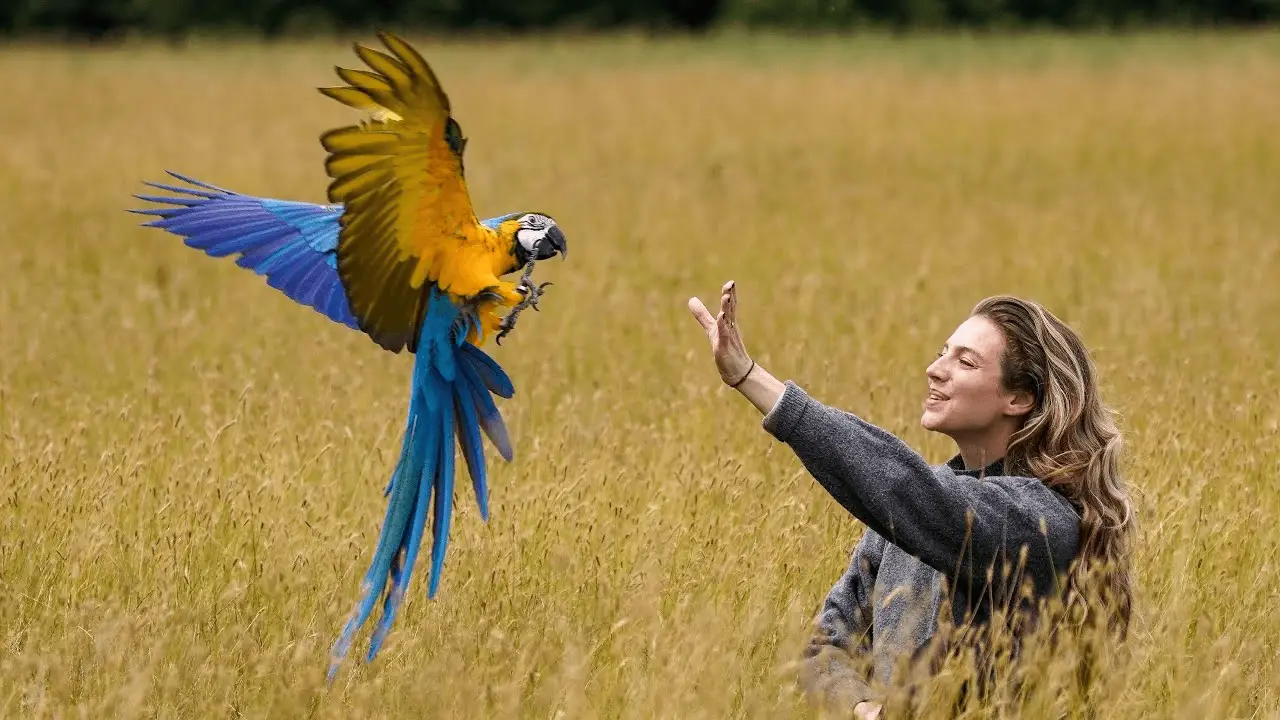
Do Parakeets Like to Be Held? The desire to hold your pet in your arms is a natural need for any pet owner. Whether it’s snuggling up to him or stroking him, it helps create a bond. As the owner of a budgie, you may be wondering if it likes to be held. After extensive research, here’s what I discovered.
Do budgies like to be held?
Parakeets are not used to being held, and some may not like it. However, it is possible to train your bird to feel more comfortable in your arms.
If you want your budgie to be relaxed and accept that you hold and scratch it, read on to discover some tips that can help you.
Can you catch a budgie?
You should never grab a budgie unceremoniously. Unless you need to grab it to get it out of a dangerous situation, you should instead focus on the bird’s signals. Forcing the budgie in your hand can terrify her. This can cause injury. It can also harm your relationship with the bird.
A better solution is to learn his signals and determine whether or not he accepts to be touched.
Parakeets, parrots, and parakeets are more open to touch than other birds. However, it all depends on the personality of the bird. If a bird had an unpleasant experience in its youth, it may be shy to the touch. Others, who have had positive experiences, will appreciate it more.
Even people who have never touched anything in their history may be frightened or delighted. Their personality plays a major role. Some birds are simply more grumpy than others.
Understanding your budgie’s signals
One of the first steps in teaching your budgie to accept your touch is to understand its signals. As with humans, if they don’t want to be touched, you have to respect their wishes. A budgie will tell you if she wants to be touched or not.
One sign that your budgie doesn’t want to be touched is that it becomes extremely rigid and stares at you. The stiffness of his posture is a defense mechanism. She tries to make you believe that she is not there. Don’t be surprised if he tries to bite you if you keep moving your hand toward him.
Another sign that your budgie doesn’t want to be touched is that it’s flying away or climbing away from your hand. She tries to take cover. The budgie perceives your hand as a danger.
These signs can also appear when you try to stroke his head. Stroking the back of your budgie’s head can feel threatening if she is not trained or used to doing so. If you continue your efforts, you risk biting him.
If your budgie remains relaxed, it means that she accepts to be touched. His posture does not stiffen. She can still stare at you, but that’s more out of interest than to prepare for a bite.
When you come into contact with your budgie, she gives other signs that indicate that she appreciates your touch. For example, she turns her head to the side. That means she wants you to scratch her there too.
Another sign is that he lowers his head. It allows you to access the back of its head where you can scratch it more.
The ultimate sign that the budgie is open to your contact is that it closes its eyes. It is a sign of confidence. The bird entrusts you with its life enough to be able to close its eyes and stop looking for a predator.

Start training during a quiet period
To start your training, you need to choose a quiet moment. This should be the time when your bird is most relaxed. If your bird is already tense and anxious, trying to touch and hold it can only make the situation worse.
The times when your budgie is usually most relaxed are after meals or just before bedtime. Their stomachs are full and their energy is low.
Once you are sure that your bird is relaxed, you need to start by talking to it and keep your hand in its field of vision. When talking to your budgie, use a soft, soothing voice. Keep your hand still and open. Moving it can seem threatening.
While talking to your bird, slowly bring your hand closer to it. Pay attention to signs that indicate whether the situation is uncomfortable or comfortable. At the first sign of discomfort, slowly remove your hand and continue talking to it. Then take a break.
You can come back a few minutes later and try again.
Start with the spout
The best place to get your budgie used to be touched is its beak. It also means that you’re probably going to get bitten a few times. Since some budgies can make you bleed, you will need to have tissues and disinfectants handy.
As before, you need to talk to your bird in a soothing way when you hold out your beak to it. Your movements should be slow. Your hand should always be in sight of your bird. If he feels comfortable with your approach, then you can lightly stroke your finger up and down along his beak.
Due to the proximity of its eyes, you will need to avoid touching them while stroking your bird’s beak. If his head moves, it can be difficult. Light caresses are the best solution.
Just stroke his beak for a while, then see if he is okay with you moving your finger just behind his beak, at the level of his face. Your goal is to caress the skin of his face there.
Throughout this transition, you need to keep talking to them in a calming way.
If it is receptive to your touch, you can move on to the next area. Your goal is to be able to stroke, or scratch, the sides of his head. This is the best place to put your budgie.
If at some point your budgie feels uncomfortable, you should slowly remove your hand and keep it in front of it. You may need to repeat this process several times if your budgie is temperamental or nervous about being touched.

Body Focus Next
Once the budgie is comfortable when you touch the sides of its head, you can move on to the body. She may try to bite you again, especially because she won’t always be able to see your hand. You can help her feel comfortable by slowly moving your hand to the sides of her body. It may take several attempts to make him feel comfortable with your touch.
Once you have successfully established contact, the method used to pet your budgie is important. You should never stroke their feathers against the current. This can irritate and make them uncomfortable.
On the contrary, you need to stroke them in the direction of feathers. Follow the orientation of the feathers.
You can also scratch the feathers from side to side.
Continue to pet your bird in this way until it relaxes. Once he has relaxed, you can start stroking the back of his head and neck.
Where does the budgie like to be touched?
Parakeets especially like to be stroked around their ears. It is on the sides of their head that they feel most comfortable and experience the most pleasure. The ultimate goal for your budgie to enjoy your touch is to be able to touch the sides of his head.
The fact that they feel comfortable with your touch is an essential part of joining their herd. Parakeets groom themselves and sometimes other members of their herd. If you start petting their feathers, they may recognize you as a member of the herd that helps them groom themselves.
However, there are some places where you should not stroke too much. The back of their head and the back of their feathers can be sensitive areas for them. If you stimulate them too much, you risk arousing the parakeet sexually. This can make them sexually frustrated since they have no outlet.
This frustration can turn into other behavioral problems. Your bird may begin to associate your hand with these bad behaviors, which can make them difficult to handle.
The best place to put your budgie is to do it on the sides of his head.
The transition from your budgie to detention
Once your budgie is comfortable being petted by you, you can start trying to hold it. It is essential that you remember how delicate budgies are. Their wings are extremely delicate. The first step is to get him to agree to perch on your finger.
Since they should be more comfortable with your hand since you stroked them, they may have no problem perching on your finger. To help her perch, you will need to raise your finger slightly above her. Parakeets can climb much easier than they can go down.
Once they are on your finger, you can bring them closer to your body and hold them gently. You should never tighten them. Instead, let them enjoy the warmth of your body and lightly run your fingers over the sides of their feathers.
Respect the limits
Not all budgies want to be held or petted. No matter how hard you try, they may be afraid of you or find you threatening. The best thing you can do as a budgie owner is to respect its boundaries.
There are many other ways to interact with your budgie. They love to socialize and play games. You can buy puzzles, swings, and mirrors that can make them extremely happy.
Just because your budgie doesn’t want to be held by you doesn’t mean she doesn’t love you.
Final Thoughts
Being able to hold or caress a budgie depends on its particular personality. Thanks to careful and patient training, you may be able to make your budgie comfortable with your touch. Understanding how to care for your bird and what its expressions mean can contribute to your successful training.
How to Gain Your Parakeet Trust
SOURCE:Alen AxP
Related Articles:
- Do budgies love their owners
- Budgie Gender
- Care for a budgie
- How to tame budgies
- Parrot lifespan
- Cockatoo lifespan
- African grey parrot lifespan
- Sun conure lifespan
- Macaw lifespan
- All types of red parrots with pictures
- All different types of green parrots with pictures
- All different types of blue parrots




















